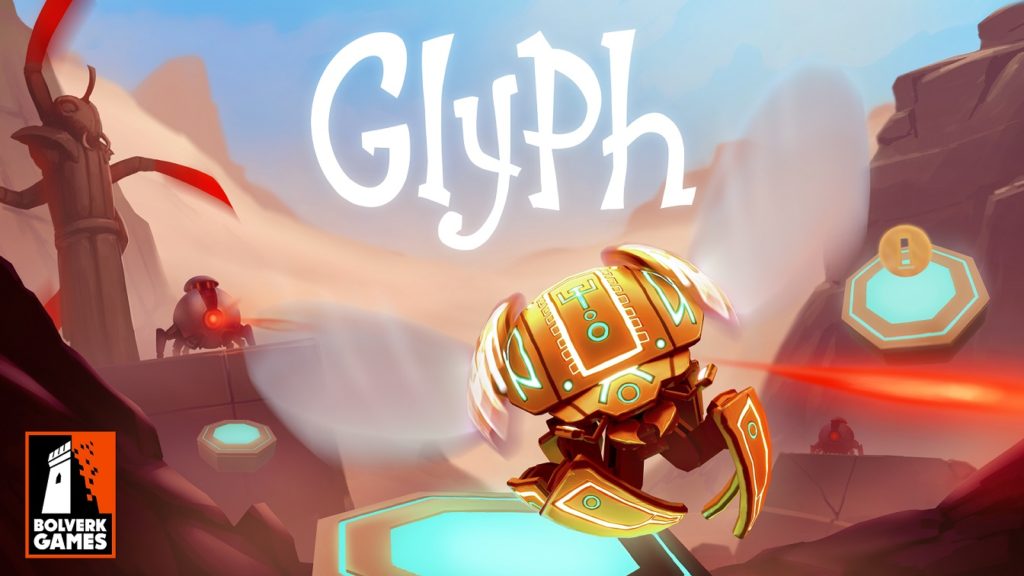Glyph is a unique 3D platformer that makes its own path within the genre with its unconventional approach to platforming mechanics. You play as a beetle from an ancient civilization that has long passed. As one of the last of your kind, you bounce, jump, and glide through stages in hopes of recovering what was once lost. The twist is that your travel mode consists of folding into a ball and utilizing the power of physics and inertia to get around. Think Samus or Hammond where momentum is both your greatest strength and weakness. Making every level feel like an ice level atop a floor made of lava is a brave move, but developer Bolverk Games manages to cultivate the potential of the unpredictability of such mechanics into a satisfying experience.

Although light in narrative, there’s enough to support a game so obviously focused on mechanics. Most of the lore is given in snippets by Anobi, our mentor, fellow beetle, and the one responsible for reviving us into the world. He accompanies us in the otherwise lonely setting, giving out information about secrets and lore on every level and pointing us in the right direction. After some instruction on movement, he leads us to our ancestral temple/ hub where it’s revealed that our main goal is to rebuild the temple. By using gold collected from completed stages, the player is able to open portals within the hub which lead to even more content. Make sure to collect the floating gems in every level, as that is the currency taken to rebuild the ancient temple.
There are many movement mechanics in the game that the player needs to employ in order to safely traverse stages, collect in-game items necessary for progression, and avoid dangerous surfaces. It’s a classic “the floor is lava” situation where touching areas outside of the prescribed platforms means death. Although lava is a real danger in the game and will instantly send you back to the start of the stage, it still pales in comparison to the true menace of the game. The persistently coarse, rough, and irritating surface which is most definitely everywhere and will 100% make you combust on the tiniest impact … I’m talking about sand. Jumping/bouncing is the player’s primary movement ability to avoid this terrifying mineral. The player recharges their ability to jump by touching platforms. This mechanic can be used in interesting ways, such as climbing up a pillar with infinite resets after a poorly aimed jump. In tandem with platforms that allow for double jumps and the gliding mechanic, the player is able to traverse great distances (and easily overshoot their targets) given enough momentum. The player also has the option to kill all momentum and smash down onto the ground directly beneath them, bouncing up as a result. With a combination of all these movement mechanics, the player explores the map for cosmetic secrets, keys to open the portal to the next stage, gems which unlock completely new areas, and avoid the evilest entity in all of the universe (sand).

The many moments of free flying accompanied by beautiful scenery is the highlight of Glyph’s gameplay. It’s a glimpse into complete freedom with every leap of faith the player takes, so long as you stick the landing of course. Death is both common and punishing as progress within levels basically resets at every death. In this way, the game often feels like it rewards patience over leaps of faith and risky mechanical maneuvers which ultimately slows down the paste of levels to a frustrating halt.
It’s also unfortunate that the smash/bounce mechanic feels clunky compared to its free spirited counterparts (gliding and double jumping). The way smashing to the ground kills all forward momentum is both unsatisfying and feels like a slap to physics’ face. Clunky camera angles and indicators aggravate the issue by making it hard to tell where you’re landing.
Even with these issues, the game’s controls are superbly tight, smoothing out many potential frustrations the players might face playing as a rolling ball. It seems that they were successful in cultivating the best parts of ball physics while dumping the frustrations. Intuitive, but challenging game play makes for satisfying play sessions in shorter periods, but might prove to be frustrating within a few hours. Not without its flaws, Glyph is a fascinating game and satisfying experience that stays true to the promise of being easy to pick up but hard to master.
Rating: 8/10
Check Out the Glyph Trailer:
You can wishlist Glyph for PC via Steam right now before it’s August 9th release date. For more information, please visit: https://playglyph.com/
Related: GLYPH Hit Platformer Announces August 9th Release Date on Steam
Shop Amazon: https://amzn.to/3jhonaW
As an Amazon Associate we earn from qualifying purchases.
Steam Review
I remember when I was a little kid, I watched my dad talk to a cowboy robot in a post-apocalyptic open world game. He kicked me out of his office, stating that the game is inappropriate for children, but I think that’s where my love of western RPGs started. Since then, I’ve grown up playing competitive games, interacting with the community, and exploring immersive worlds. I’m definitely an old soul as my favorite games include all of the old Fallout games, RPGs with classical elements such as Divinity: Original Sin 2, and the all-time great Vampire the Masquerade: Bloodlines





More Stories
Highly Anticipated Post-Apocalyptic MMO FPS, PIONER, Launches on Steam Early Access
DAIMON BLADES Preview for Steam Early Access
ReStory Preview for Steam